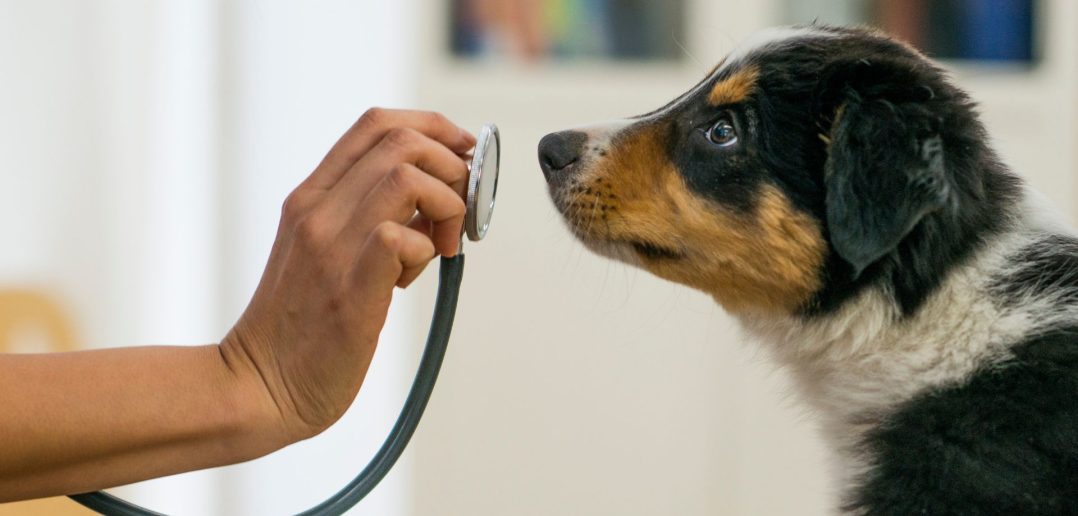Dogs can face many health issues throughout their lives. Some are common and easily treated, while others can be dangerous if not caught early. The good news is that many serious diseases can be prevented or managed with regular vet visits, vaccinations, and a good understanding of the signs to look out for.
Here are ten dog diseases every pet parent should know about, along with the basics of how to spot them and what to do.
1. Obesity
Pet obesity rates in the United States have been steadily increasing for decades, reaching 59% of dogs classified as overweight or having obesity in 2022. (State of U.S. Pet Obesity 2022)
Obesity is a serious medical problem in dogs. Exercise, proper nutrition, and withholding the dog’s intake of human food will help prevent obesity in your dog. Carrying too much weight isn’t just a cosmetic issue. Obesity in dogs can lead to joint pain, diabetes, heart disease, and a shorter life overall.
Signs to watch for:
- You can’t feel your dog’s ribs easily
- Your dog lacks a visible waist or has a round belly
- They get tired easily or avoid physical activity
Prevention tips:
Feed a healthy diet, avoid giving table scraps, and make exercise part of your daily routine. Ask your vet how many calories your dog actually needs.
BCS chart from the Association for Pet Obesity Prevention
2. Rabies
Rabies is one of the most feared viral diseases in both animals and people. Once symptoms appear, it is nearly always fatal.
Signs to watch for:
- Sudden behavior changes like aggression or confusion
- Trouble swallowing or excessive drooling
- Paralysis or staggering
What you can do:
Make sure your dog gets the rabies vaccine as required by law. Keep them away from wild animals and unfamiliar pets.
3. Canine Parvovirus (Parvo)
Parvo is a highly contagious virus that mostly affects puppies, but unvaccinated adult dogs can get it too. It can be fatal within a few days if not treated quickly.
Signs to watch for:
- Bloody diarrhea and vomiting
- Lethargy and dehydration
- Loss of appetite
What you can do:
Complete the full puppy vaccine series before letting your dog socialize in public places. If your dog shows symptoms, get to a vet right away.
4. Canine Coronavirus
This virus affects the gastrointestinal system. It usually isn’t fatal, but it can make your dog very uncomfortable.
Signs to watch for:
- Vomiting and diarrhea
- Lethargy and reduced appetite
What you can do:
There is a vaccine for it, but many vets only recommend it for dogs in high-risk environments.
ScienceDirect – Canine coronavirus
5. Distemper
Distemper is a very serious virus that affects the nervous, gastrointestinal, and respiratory systems. It can be deadly.
Signs to watch for:
- Nasal discharge and coughing
- Seizures or twitching
- Fever, vomiting, and diarrhea
What you can do:
Make sure your dog gets all required distemper vaccines and boosters. Avoid contact with stray or unvaccinated dogs.
6. Kennel Cough
This is a respiratory illness marked by inflammation of the larynx, trachea, and bronchial tubes. It typically spreads among dogs in places like shelters, grooming salons, and boarding facilities.
Signs to watch for:
- Dry, hacking cough
- Sneezing or nasal discharge
- Retching or gagging
What you can do:
The recommended prevention is vaccination against four of the strains, which may be needed as often as every six months. Ask your vet if your dog needs a Bordetella vaccine, especially if they spend time around other dogs.
AVMA – Canine infections respiratory disease complex
7. Leptospirosis
This bacterial infection can cause kidney or liver failure and can be passed to humans.
Signs to watch for:
- Fever and vomiting
- Increased thirst or urination
- Jaundice or muscle tenderness
What you can do:
Talk to your vet about the leptospirosis vaccine if you live in an area with high exposure risk, especially if your dog swims in lakes or drinks from puddles.
Cornell Vet Med – Canine leptospirosis
8. Infectious Canine Hepatitis
Also known as ICH, this disease is caused by the canine adenovirus and can affect the liver, kidneys, and blood vessels.
Signs to watch for:
- Fever and abdominal pain
- Vomiting and loss of appetite
- Cloudiness in the eyes or yellowing of the gums
What you can do:
Keep your dog up to date on the DHPP vaccine, which includes protection against this disease.
AKC – Signs, Symptoms and Treatments of Canine Hepatitis
9. Lyme Disease
This tick-borne illness can lead to joint pain, fever, and long-term complications if not treated.
Signs to watch for:
- Limping or stiffness
- Swollen joints or lymph nodes
- Lethargy and fever
What you can do:
Use monthly tick prevention and ask your vet whether the Lyme vaccine is right for your dog based on where you live.
10. Heartworm Disease
These parasites are spread by mosquitoes and can live in your dog’s heart and lungs. In serious cases, heartworm can be fatal.
Signs to watch for:
- Persistent cough
- Fatigue after light activity
- Weight loss or trouble breathing
What you can do:
Use heartworm prevention every month and make sure your dog gets tested once a year. Even indoor dogs can be at risk.
American Heartworm Society – Heartworm Basics
Dogs rely on us to keep them healthy. The more you know about common diseases, the better prepared you’ll be to protect your pup.
Stick to regular vet checkups, follow the vaccine schedule, use year-round preventatives for heartworms and ticks, and trust your instincts. If something feels off, it’s always worth a call to your veterinarian!





8 Comments
Great information that all dog owners should have especially those who don’t bother to get their dog’s yearly shots.
YEARLY SHOTS????????
ARE YOU INSANE?
Leading Veterinary Vaccine Researcher, Dr. Ron Schultz advises ONE vaccine at 15 weeks good for the life of the dog! To do yearly vaccines you are destroying the dogs immune system and increasing chance of advserse reactions, VACCINOSIS!
The dog can be examined yearly but yearly vaccines have not been advocated for since 1978!!!!! WHERE HAVE YOU BEEN UNDER A ROCK!
Sad to see that obesity is not only a problem for modern humans but for our pets as well. Along with altering the diet, exercise may help. In fact, it might help both pet and human companion! There are some exercises you can do while getting your dog or cat in the act too. Though we would not recommend getting your cat TOO involved in any of these, seeing as how fickle those felines can be. Dogs, meanwhile, are usually up for anything it seems.
Dogs are easy to take care of…and exercising with them is a great bonding for you and your pet.
To avoid different diseases that can affect your pet, just always take them to the vet for regular check up and most of all love them and treat them as part of your family.
There is a saying,”If your dog is fat, you’re not getting enough exercise.” This is a problem we as pet owners need to take control of.
This is a great article — but I have to say that I personally shy away from over vaccinating my dogs. The traditional heart worm medicine is a must no matter where you live, but there are some great alternatives for fleas, ticks and other parasites. Obesity is something that dog owners have complete control over and it’s really a matter of being a responsible dog owner by providing exercise and not giving your dog a little of everything that you eat.
I don’t think most dog owners have to worry much about kennel cough unless they take their dog to a kennel, dog park or they recently adopted one from the shelter who is showing signs.
I recently interviewed Dr. Shawn Messonnier, Veterinarian and vaccinations were one of the topics. His response was that “no pets require vaccinations every year. Research shows that immunity lasts at least 3 years.”
Hi
Great Info, Thanks for sharing. Love your blog.
Find a veterinarian you can trust and visit regularly. Ideally, routine wellness examinations should be performed by your vet twice a year. Puppies and senior dogs should be seen even more frequently. Because dogs age at a faster rate than us, many subtle changes can develop over a six to twelve month period. Routine visits allow your vet to closely monitor changes before your dog’s health gets out of control.